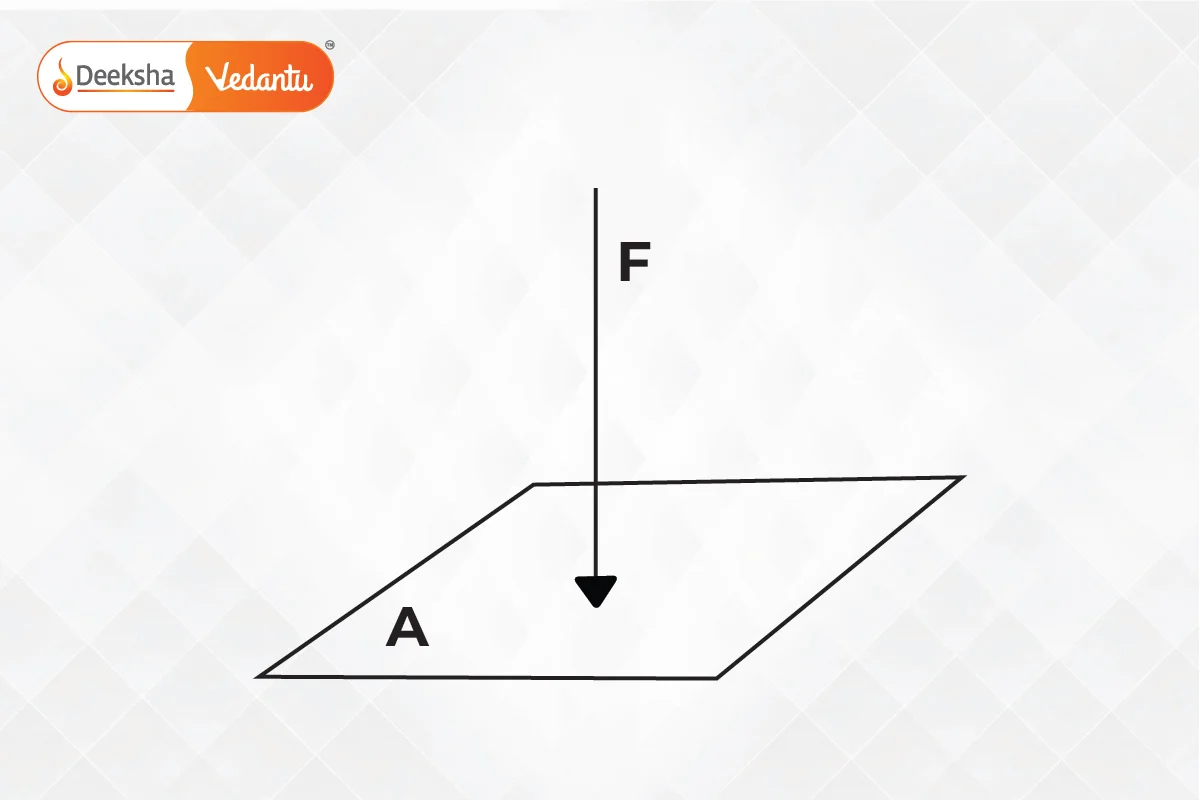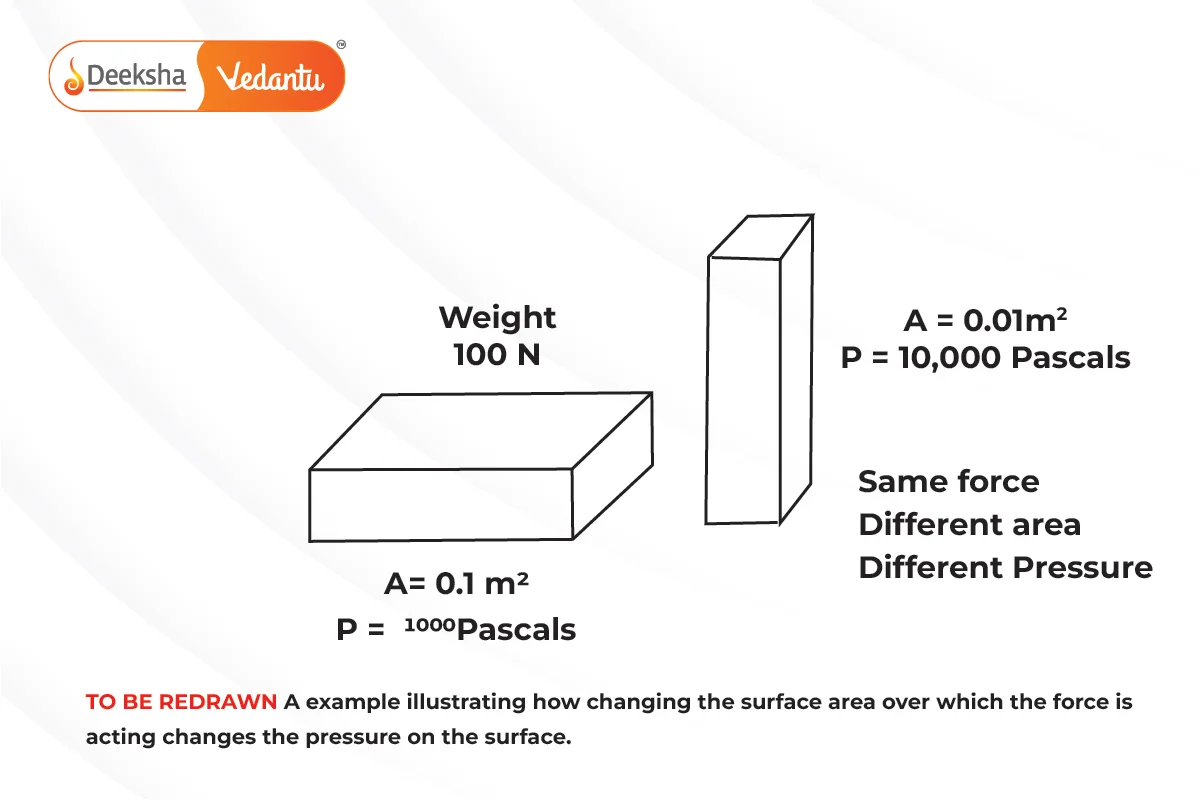What is Pressure?
Pressure is the amount of force applied per unit area on the surface of an object. It is a fundamental concept in physics that explains how force is distributed over an area. In our daily lives, we encounter pressure in various forms, whether it’s the pressure exerted by a gas inside a container, the pressure beneath a liquid, or the atmospheric pressure exerted by the air around us.

Formula for Pressure:
The mathematical expression for pressure () is:
Where:
is the pressure,
is the force applied (in Newtons,
),
is the area over which the force is applied (in square meters,
).
The SI unit of pressure is the , which is equivalent to 1 Newton per square meter
.
Types of Pressure
1. Atmospheric Pressure:
- Definition: Atmospheric pressure is the pressure exerted by the weight of the Earth’s atmosphere on objects. It decreases with increasing altitude (height above sea level).
- Standard Atmospheric Pressure: At sea level, the atmospheric pressure is approximately
or
. This is the pressure that supports a column of mercury 760 mm high in a barometer.
- Applications: Barometers measure atmospheric pressure, and this helps predict weather changes.
2. Hydrostatic (Liquid) Pressure:
- Definition: The pressure exerted by a liquid at rest due to the weight of the liquid above it. Hydrostatic pressure increases with depth.
- Formula:
Where:is the height (or depth) of the liquid column,
is the density of the liquid,
is the acceleration due to gravity (
).
- Applications: The concept of hydrostatic pressure explains why deeper waters in oceans or swimming pools exert more pressure. It is also used in designing dams and water tanks, as greater depths generate higher pressure.
3. Gauge Pressure:
- Definition: Gauge pressure is the pressure relative to atmospheric pressure. It is used to measure pressures in systems like car tires and gas cylinders.
- Formula:

Factors Affecting Pressure
- Force Applied: Pressure increases when a greater force is applied over a given area.
- Surface Area: Pressure is inversely proportional to the area over which the force is applied. For example, a sharp needle exerts more pressure on your skin than a blunt object because the force is concentrated over a smaller area.
- Depth in Fluids: In fluids, pressure increases with depth. The deeper an object is submerged in a fluid, the higher the pressure exerted on it.
Pressure in Fluids
Fluids include liquids and gases that can flow and change shape. The pressure in fluids acts in all directions and increases with depth. A practical example of this is how divers experience greater pressure as they dive deeper into the water.
Pascal’s Law:
Pascal’s Law states that when pressure is applied to a confined fluid, it is transmitted equally in all directions. This principle is the basis for hydraulic machines, which use liquids to multiply force. The formula derived from Pascal’s law is:
Where:
and
are the forces applied at two different areas (
and
) of the hydraulic system.
Applications of Pascal’s Law:
- Hydraulic Lifts: Used in car garages to lift vehicles using the multiplication of force.
- Hydraulic Brakes: Found in cars and trucks where pressure applied on the brake pedal is transmitted through brake fluid to stop the vehicle.
Applications of Pressure in Daily Life
- Hydraulic Systems: Hydraulic presses and lifts use the principle of liquid pressure to lift heavy objects by applying a small force over a larger area.
- Blood Pressure: In the human body, blood pressure refers to the force exerted by circulating blood on the walls of blood vessels. It is measured in systolic and diastolic values.
- Airplane Flight: Pressure differences across the wings of an airplane create lift, allowing the airplane to fly.
- Syringes and Pumps: Pressure differences are used in medical syringes and water pumps to move fluids from one place to another.
- Vacuum Cleaners: Use low pressure to suck in air and dirt.
Numerical Example: Pressure in Liquids
A diver is 10 meters below the surface of the water. Calculate the pressure exerted on the diver at this depth.
Given:
,
,
.
Using the formula :
Thus, the pressure exerted on the diver is or
.
FAQs
Pascal’s Law states that pressure applied to a confined fluid is transmitted equally in all directions. This principle is used in hydraulic systems like car lifts and braking systems.
A sharp knife has a smaller surface area in contact with the object, which increases the pressure for a given force, making it easier to cut.
Atmospheric pressure is the pressure exerted by the Earth’s atmosphere on all objects. It is approximately at sea level.
The SI unit of pressure is the Pascal (Pa), which is equivalent to one Newton per square meter .
Hydraulic systems use pressure applied at one point to be transmitted through a fluid to another point, effectively multiplying the force applied. This principle allows for mechanisms like hydraulic lifts and brakes to function effectively.
Pressure cookers increase the boiling point of water by increasing the pressure inside the cooker. This allows food to cook faster and more efficiently at higher temperatures.
In the context of atmospheric and fluid pressures, negative pressure typically refers to a partial vacuum. However, absolute negative pressure is not physically meaningful in those contexts.
Atmospheric pressure variations are crucial in weather formation. Low pressure often leads to cloud formation and precipitation, while high pressure tends to bring clear skies.
In fluids, pressure increases with depth due to the weight of the fluid above increasing the force over a given area.
Related Topics
- P-N Junction
- Protection Against Earthquake
- Electricity
- Ohm’s Law
- Acceleration
- Fleming’s Left-Hand Rule and Right-Hand Rule
- Magnetic Field Due To A Current – Carrying Conductor
- Force
- Velocity
- List of Physics Scientists and Their Inventions
- Magnetic Field And Field Lines
- The Human Eye And The Colourful World
- Scattering Of Light
- The Human Eye
- Refraction Of Light













Get Social